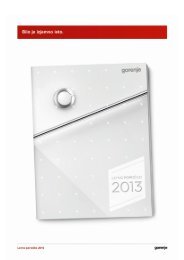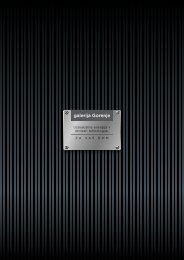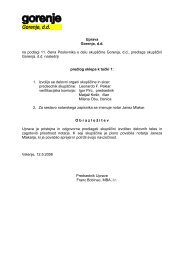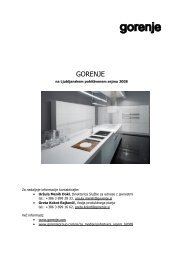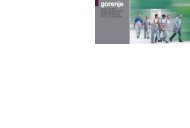Annual Report Gorenje Group 2009
Annual Report Gorenje Group 2009
Annual Report Gorenje Group 2009
You also want an ePaper? Increase the reach of your titles
YUMPU automatically turns print PDFs into web optimized ePapers that Google loves.
Deferred tax is measured at the tax rates that are expected to be applied to temporary differences<br />
when they reverse, based on the laws that have been enacted or substantively enacted by the<br />
reporting date.<br />
Deferred tax assets and liabilities are offset if there is a legally enforceable right to offset current tax<br />
liabilities and assets, and they relate to income taxes levied by the same tax authority on the same<br />
taxable entity, or on different tax entities, but they intend to settle current tax liabilities and assets on a<br />
net basis or their tax assets and liabilities will be realised simultaneously.<br />
A deferred tax asset is recognised to the extent that it is probable that future taxable profits will be<br />
available against which they can be utilised. Deferred tax assets are reduced to the extent that it is no<br />
longer probable that the related tax benefit will be realised.<br />
o) Earnings per share<br />
The Company presents basic and diluted earnings per share (EPS) data for its ordinary shares. Basic<br />
EPS is calculated by dividing the profit or loss attributable to ordinary shareholders of the Company by<br />
the weighted average number of ordinary shares outstanding during the period.<br />
p) Comparative information<br />
Comparative information has been harmonised with the presentation of information in the current year.<br />
Where required, adjustment of comparative information has been carried out in order to comply with<br />
the presentation of information in the current year.<br />
r) New standards and interpretations not yet adopted<br />
Other than those adopted early as explained in note 2(e), a number of new standards, amendments to<br />
standards and interpretations are not yet effective for the year ended 31 December <strong>2009</strong>, and have not<br />
been applied in preparing these financial statements of the Company. None of these will have an effect<br />
on the financial statements of the Company, except for Eligible Hedged Items - Amendment to IAS 39<br />
Financial Instruments: Recognition and Measurement, which clarifies the existing principles that<br />
determine whether specific risks or portions of cash flows are eligible for designation in a hedging<br />
relationship. The amendment, which becomes mandatory for the Company's 2010 financial statements,<br />
is not expected to have a significant impact on the financial statements.<br />
COMPANY - SUPPLEMENTS TO IAS<br />
Amendment to IAS 32 Financial Instruments: Presentation - Classification of Rights<br />
Issues (effective for annual period beginning on or after 1 February 2010)<br />
The amendment requires that rights, options or warrants to acquire a fixed number of the entity’s own<br />
equity instruments for a fixed amount of any currency, are equity instruments if the entity offers the<br />
rights, options or warrants pro rata to all of its existing owners of the same class of its own nonderivative<br />
equity instruments.<br />
The amendments to IAS 32 are not relevant to the Company’s financial statements as the Company<br />
has not issued such instruments at any time in the past.<br />
186<br />
<strong>Annual</strong> <strong>Report</strong> <strong>Gorenje</strong> <strong>Group</strong> <strong>2009</strong>



